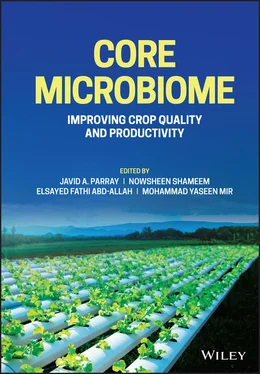1 ...8 9 10 12 13 14 ...25
2.4.2.4 Induced Systemic Resistance
The Plant immune system responds the same way toward both pathogenic and nonpathogenic microbes. However, response toward nonpathogenic microbes remains mild as they lack virulence factors. The ISR mechanism is well characterized in the rhizosphere and endosphere. Sphingomonas melonis fr1, a phyllosphere bacteria, suppressed disease development in Arabidopsis thaliana by inducing camalexin production [108]. Camalexin is a tryptophan-derived alkaloid that interferes with the membrane integrity of bacteria and fungi [109]. Foliar application of Bacillus amyloliquefasciens 5B6 decreased the relative abundance of cucumber mosaic virus by activating SA and ethylene signaling pathway in three years of field trials [110].
2.4.3 Plant Disease Management
Pathogens and pests are responsible for 15–30% of crop yield losses worldwide [111]. We depend on chemical-based crop production and protection strategies using chemical fertilizers, pesticides, herbicides, and fungicides for a sufficient and steady yield. Biological chemical-free agriculture is gaining more and more support ecologically. For disease control, ecological control has been the desirable policy in which nonpathogenic microorganisms are applied to the foliar parts of the plant to affect disease suppression [112]. Microorganisms of the phyllosphere take over a large assortment of adaptation and biocontrol factors, which permit them to adopt the phyllosphere condition and discourage pathogen growth, thus assisting in plant health [113].
The genera of Pantoea and Sphingomonas have a vital contribution to wildfire disease inhibition [114]. Bacillus amyloliquefaciens as a biocontrol agent to mandarin fruit suppresses Penicillium digitatum infection by 77% [115]. Trichoderma atroviridae can be correlated with reduced infection of Botrytis cinerea in strawberries by 88% [116]. Black leaf streak disease in bananas caused by Pseudocercospora musae is restrained by Bacillus subtilis B106 up to 72% [117]. The biocontrol agent Trichoderma koningii controls up to 93% of Phytophthora cactorum pathogen that causes collar rot in apples [118]. Similarly, infection caused by Phytophthora medium in rubber trees can be controlled by using biocontrol agents, such as Alcaligenes sp . EIL-2 [119].
2.5 Conclusion and Prospects
We studied the plant microbiome, aiming to elucidate on the new and improved tools for developing products that can enhance disease management. Our first step was to explore and discover prospective products that can invade phytopathogens and help in maintaining the overall health of plants. Plant microbiota are very useful in improving plant growth as they produce secondary metabolites that confer resistance to a wide variety of pathogens. As a whole, metabolites secreted by the plant microbiome will offer an immense contribution in opening up new opportunities to fight challenges in the environment and agriculture. Finally, the advances in metagenomics combined with NGS techniques will uncover new pools of defense metabolites by novel microbes in the rhizosphere, endosphere, and phyllosphere.
1 1Kumar, V., Prasad, R., Kumar, M., and Choudhary, D.K., (eds). (2019). Microbiome in Plant Health and Disease: Challenges and Opportunities. Springer. Aug 10.
2 2Hammonds, K., Trivedi, P., Garg, A., Janitz, C., Grinyer, J., Holford, P., Botha, F.C., Anderson, I.C., and Singh, B.K. (2018). Field study reveals core plant microbiota and the relative importance of their drivers. Environmental Microbiology Jan 20 (1): 124–140.
3 3Mendes, R., Garbeva, P., and Raaijmakers, J.M. (2013). The rhizosphere microbiome: Significance of plant beneficial, plant pathogenic, and human pathogenic microorganisms. FEMS Microbiology Reviews Sep 1 37 (5): 634–663.
4 4Tkacz, A. and Poole, P. (2015). Role of root microbiota in plant productivity. Journal of Experimental Botany Apr 1 66 (8): 2167–2175.
5 5Baetz, U. and Martinoia, E. (2014). Root exudates: The hidden part of plant defense. Trends in Plant Science Feb 1 19 (2): 90–98.
6 6Hu, L., Robert, C.A., Cadot, S., Zhang, X., Ye, M., Li, B., Manzo, D., Chervet, N., Steinger, T., Van Der Heijden, M.G., and Schlaeppi, K. (2018). Root exudate metabolites drive plant-soil feedbacks on growth and defense by shaping the rhizosphere microbiota. Nature Communications Jul 16 9 (1): 1–3.
7 7Tkacz, A. and Poole, P. (2021). The plant microbiome: The dark and dirty secrets of plant growth. Plants, People, Planet Mar 3 (2): 124–129.
8 8Parniske, M. (2008). Arbuscular mycorrhiza: The mother of plant root endosymbioses. Nature Reviews Microbiology Oct 6 (10): 763–775.
9 9Claesson, M.J., Wang, Q., O’Sullivan, O., Greene-Diniz, R., Cole, J.R., Ross, R.P., and O’Toole, P.W. (2010). Comparison of two next-generation sequencing technologies for resolving highly complex microbiota composition using tandem variable 16S rRNA gene regions. Nucleic Acids Research Dec 1 38 (22): e200.
10 10Schoch, C.L., Seifert, K.A., Huhndorf, S., Robert, V., Spouge, J.L., Levesque, C.A., and Chen, W. (2012). Fungal Barcoding Consortium. Nuclear ribosomal internal transcribed spacer (ITS) region as a universal DNA barcode marker for Fungi. Proceedings of the National Academy of Sciences Apr 17 109 (16): 6241–6246.
11 11Sessitsch, A., Hardoim, P., Döring, J., Weilharter, A., Krause, A., Woyke, T., Mitter, B., Hauberg-Lotte, L., Friedrich, F., Rahalkar, M., and Hurek, T. (2012). Functional characteristics of an endophyte community colonizing rice roots as revealed by metagenomic analysis. Molecular Plant–Microbe Interactions Jan 25 (1): 28–36.
12 12Wang, X., Wang, M., Xie, X., Guo, S., Zhou, Y., Zhang, X., Yu, N., and Wang, E. (2020). An amplification-selection model for quantified rhizosphere microbiota assembly. Science Bulletin Mar 7 65 (12): 983–986.
13 13Prashar, P., Kapoor, N., and Sachdeva, S. (2014). Rhizosphere: Its structure, bacterial diversity and significance. Reviews in Environmental Science and Bio/Technology Mar 13 (1): 63–77.
14 14Garbeva, P.V., Van Veen, J.A., and Van Elsas, J.D. (2004). Microbial diversity in soil: Selection of microbial populations by plant and soil type and implications for disease suppressiveness. Annual Review of Phytopathology Sep 8 42: 243–270.
15 15Schreiter, S., Babin, D., Smalla, K., and Grosch, R. (2018). Rhizosphere competence and biocontrol effect of Pseudomonas sp. RU47 Independent from Plant Species and Soil Type at the Field Scale. Frontiers in Microbiology Feb 1 9: 97.
16 16Robin, A., Mazurier, S., Mougel, C., Vansuyt, G., Corberand, T., Meyer, J.M., and Lemanceau, P. (2007). Diversity of root-associated fluorescent Pseudomonads as affected by ferritin overexpression in tobacco. Environmental Microbiology Jul 9 (7): 1724–1737.
17 17Di Pietro, A., Lorito, M., Hayes, C.K., Broadway, R.M., and Harman, G.E. (1993). Endochitinase from Gliocladium virens: Isolation, characterization, and synergistic antifungal activity in combination with gliotoxin. Phytopathology.
18 18Harman, G.E., Petzoldt, R., Comis, A., and Chen, J. (2004). Interactions between Trichoderma harzianum strain T22 and maize inbred line Mo17 and effects of these interactions on diseases caused by Pythium ultimum and Colletotrichum graminicola. Phytopathology Feb 94 (2): 147–153.
19 19Amadou, M., Duponnois, R., and Marseille, T. (1999). Beneficial effects of Enterobacter cloacae and Pseudomonas mendocina for biocontrol of Meloidogyne incognita with the endospore-forming bacterium Pasteuria penetrans. Nematology Jan 1 1 (1): 95–101.
20 20Haas, D. and Keel, C. (2003). Regulation of antibiotic production in root-colonizing Pseudomonas spp. and relevance for biological control of plant disease. Annual Review of Phytopathology Sep 41 (1): 117–153.
Читать дальше











